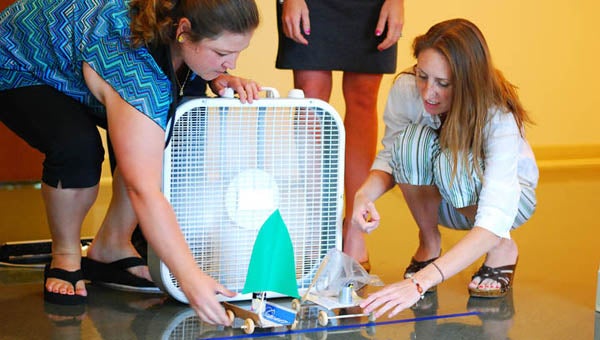Carrsville science teacher learns hands-on approach
Published 2:59 pm Wednesday, July 24, 2013

Emma Ingram, left, and Robin Gafa, of Carrsville Elementary School, try out wind-powered vehicles they made. This was part of the Virginia Initiative for Science Teaching and Achievement, which was a two-week course at The College of William and Mary. SUBMITTED PHOTO
CARRSVILLE—Robin Gafa, who teaches science at Carrsville Elementary School, applied for a program through Virginia Institute for Science Teaching and Achievement to learn a different approach to teaching science at The College of William and Mary. The approach encourages children to experiment on their own.
“It just makes things more realistic for them,” said Gafa, who has been teaching for eight years, six of those at Carrsville Elementary School. “They are just going to be engaged in projects and experiments, instead of being given the material or being told step by step; instead, they have to design and engineer things for themselves.”
One project she worked on with children volunteering was to have the students create a solar-powered oven.
“They had to cook a s’more,” Gafa said. “They had to design an oven that would work. When it did not, they had to go back and figure out what to do differently. They were applying science, but figuring it out on own, instead of me giving it to them.”
Now that she has experienced this way, she prefers it.
“It is really neat because you see them make connections for themselves,” Gafa said. “You are not feeding them info. They are generating questions and solutions to problems on their own.”
The project itself has been a good experience for Gafa.
“They had us just doing and making all kinds of different things,” she said. “During two days of the course, we were visited by a physicist and a biologist. We went canoeing on lake with the biologist, and he explained different things to us. The physicist showed us around the building, and we made a small motor.”
Vicky Reid, director of VISTA operations at William and Mary, said the VISTA grant is based on 15 years of research, which claims that student test scores increase by 10 percent if project-based learning is in place.
“VISTA is a state-wide project, a partnership, to improve science teaching and students achievement state of Virginia,” Reid said. “Using researched-based methods of good science instruction, that if teachers learn how to do that and implement, student achievement will improve.”
The program is set up where teachers apply and get accepted in teams, but in Carrsville’s case, one teacher had to drop out. During the two-week program, teachers learn methods to teach hands-on science, then they practice it on children who volunteer to come in. Finally, the teachers work with program leaders to develop a curriculum, so that teachers can implement it during the school year.
For the program, each teacher receives a $5,000 stipend and $1,000 in teaching resources, science materials and web content for their classroom.
“It has been really fun, and I’ve learned a lot of different things,” Gafa said.





